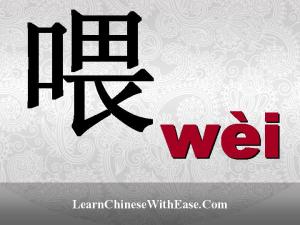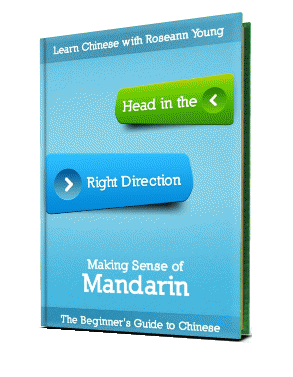How to Say Hello in Chinese
To get started with how to say hello in Chinese, it’s important to know PinYin (the romanization/phonetics/alphabet) of the Chinese language.
For example, you can see what the PinYin looks like by viewing the letters written beneath the characters:
The pronunciation is similar to “knee how,” but notice that there are also markings above some of the vowels. This let’s you know the tone to use when speaking the words in Chinese. The tone marking you see above is known as the third tone or the “falling and rising tone.” That is because your voice must fall and rise in pitch in order to say the tone correctly. For more on how to Learn to Speak Chinese , read this eBook on your tablet with the Kindle app.
You’ll see what I mean by taking a look at this video on hello in Chinese . . .
If you found this post or video helpful, download your free copy of the study guide.
Hello in Chinese Said Politely
Hello in Chinese–the Polite Version
This more polite version of hello in Chinese should always be used when addressing the elderly, but is also very appropriate at formal occasions for your peers or those to whom you wish to show respect. Since this phrase is SO close to the common greeting, you might want to pay special attention to the first Chinese character. Instead of “nĭ” said with the third tone, you will say “nín” said with the second tone which is a rising pitch. The pronunciation is much like “knee” but with an added “n” on the end, making it “kneen.”
Don’t forget to download your free study guide.
How to Say “HI” in Chinese
Although hello in Chinese is the standard form of how to say hello in Chinese, you can also say “hi” in Chinese. But, you will find that hi in Chinese is used much differently than where we would normally say hi!
I’ll try to explain it by situations so that you can see what I mean.
Hi in Chinese: in Conversation
First, you can say hi in Chinese almost like we would say, “Hey!” As in “Hey, how are you?” you could appropriately use the first version of hi in Chinese.
Notice that the Chinese character for hi in Chinese is pronounced “wèi” which sounds like our version of “way” but said with a falling fourth tone. That means that you should start just higher than your normal speaking voice and then drop your pitch as you say the word. It’s much like sighing, so think of “sigh” as you say the word “way” and you’ll have the first hi in Chinese down without a problem!
Hi in Chinese: on the Phone
Second, you’ll find that a type of hi in Chinese is used as people answer the telephone in Mainland China. Now in other Chinese-speaking countries, this might be considered rude, but in Mainland China it’s considered practical and a part of everyday life…
So, this hi in Chinese is almost like our “yes” as we are answering the telephone where someone might say, “Yes? Hello?” The literal meaning of this Chinese character, however, is “yea” much like our modern yes, but many still consider this phrase a way to say, “Hi. Hello.” as is commonly said on the phone.
In order to say this version of hi in Chinese, it’s pronounced “wĕi” which means that you’re still going to use “way,” but that your voice will do something else! (It’s a little tricky, but it can be done)! So, to pronounce this, you would start out at your normal speaking voice, lower the pitch for a period of time, and THEN raise the pitch at the end.
I know, it’s crazy—a little like acrobatics for the voice! (Think of when you say, out of frustration “oh,” or when you might say “no” to someone to demonstrate that it’s not like that at all! This is the type of sound you’re looking for). For more on Chinese tones, visit my blog.
Now, you can see two different ways to say hi in Chinese—one almost like “hey” and the other for when answering the phone. See, the Chinese language can be quite an adventure just in saying hi in Chinese!
Did you get your free study guide yet? It will really help!
How Are You in Chinese
Video on How Are You in Chinese
How are you in Chinese is closely linked to the Chinese phrase for hello in Chinese. The Chinese language is quite interesting when you follow some of the connections between Chinese characters or Chinese phrases! Still, you’ll find this video on how are you in Chinese easy to follow.
Review of How Are You in Chinese
From the video, you’ve gathered that asking how are you is as simple as three Chinese characters, 你好吗? Yet, saying this Chinese phrase with the right Chinese tones is probably the most important part of asking this question. With the tones said properly, though, you’re off to a great start in Mandarin Chinese! Best to you in saying, “How are you?” in Chinese!
More on How Are You in Chinese
For a less formal means of asking how are you in Chinese, you should try 你怎么样? This phrase is used when you already know someone and is closer to asking, “How have you been?” or “How’s it going?” But, if that’s what you’re trying to communicate by asking how are you in Chinese, you should probably use this phrase.
Let’s take a closer look at this more familiar Chinese phrase.
- 你 (nǐ or “knee”) is said with the falling and rising third tone for “you”
- 怎么 (zěn me or “dsen muh”) is said with the third tone and then the neutral tone for “how”
- 样 (yàng or “young”) is said with the falling forth tone and means “state or condition”
Using How Are You in Chinese
Now, whether you’re addressing someone you just met with 你好吗? or talking with someone you know pretty well and asking 你怎么样?, you’ll be able to ask, “How are you?” in Chinese properly!
Chinese Alphabet
Video of the Chinese Alphabet
If you’re interested in learning how to speak Mandarin Chinese, then a great way to start is to learn the Chinese alphabet. Of course, knowing Chinese tones FIRST really helps, but this will give you a general overview of what it’s like to get acquainted with the Chinese alphabet.
Take a moment to watch this video on the Chinese alphabet and learn a little more about the two categories of sounds:
- Chinese Initials
- Chinese Finals
The Chinese Alphabet: So What?
With these two categories of sounds, you’ll be able to read anything in Chinese PinYin. That means that you can look at any text that has Chinese characters as well as PinYin and be able to read it! It’s like putting on training wheels so that you can navigate anywhere in the Chinese language.
Of course, some day you’ll want to take off those training wheels and actually be able to read characters without the Chinese PinYin written below it. But, until that time, the Chinese alphabet is a great help in learning Chinese!
Please in Chinese
Please in Chinese Video
If you want to know how to say please in Chinese, take a moment to watch this video that gives the Chinese phrase, the characters, and the PinYin for saying please in Chinese.
Saying Please in Chinese
Common
The common phrase for please in Chinese is 请 (qǐng) said with the falling and rising third tone. This Chinese character usually begins the sentence and is used for making a polite request.
Uncommon
There is also another phrase for please in Chinese that’s not used quite as often. When you are pleading with someone or begging them, then you would use 拜托了(bài tuō le) instead. Although you probably won’t hear or use this phrase as often, it still is important to know when you’re in a desperate situation.
Four Tones of Chinese
There’s just no underestimating the importance of the tones as you are speaking the Chinese language. Of course, the trick is to either
- think of them as though you are singing OR
- associate the tones with sounds you already know in English.
So, here’s my attempt at making this as easy as possible.
- 1st TONE is pretty annoying and sounds like when you say “Aaahhhhhhhhhh” at the doctor’s or dentist’s office.
- 2nd TONE is like asking a question because your voice rises at the end–like asking, “Huh?”
- 3rd TONE is a little complex because it falls & rises, but is close to the sound of exasperation or frustration, “Oh!” or “No!”
- 4th TONE is like a sigh of relief because your voice falls slowly over time.
To listen to the four tones briefly, click here.
Learning Chinese
Overview of Learning Chinese
Knowing how the Chinese language is different from English is the first step toward success in Mandarin Chinese! Once you have a basic understanding of these differences, then it becomes easy to focus on the essentials.
- This language focuses on ideas rather than individual words.
- Chinese characters are the way to express these ideas.
- Others will only be able to understand your Chinese when you use tones that are a lot like singing.
- Mandarin Chinese has four tones.
- Once tones are mastered, PinYin will be the best way to master Chinese sounds.
The Essentials of Learning Chinese
To become fluent in Mandarin, being able to speak the four tones is crucial! (If you can’t speak them, no one will know what you’re saying)! Once tones become like second nature, you’ll be ready to move on to the “alphabet” of the Chinese language–which is PinYin.
So, in review, focus on
(Click on the links above for more detailed information on these topics). Of course, if you’re ready to learn Chinese fast, then download my free study guide by clicking on the study guide to the right.
Good luck on your journey!
Asking Questions in Chinese
How to Ask Questions in Chinese
If you’ve ever wondered how to ask a question in Chinese, then join the rest of us who often must pause to figure out whether or not we’re asking it correctly! Indeed, you’ll find that asking questions in Chinese is actually easier than in English. It is, however, something you need to get used to in order to do well.
How to Ask Questions
In English, you can start with the question like, “What is her name?” When you answer this in English, you have to reorder the sentence by beginning with the end in stating, “Her name is ________.” In this case, to properly answer the question, you are required to reorder the sentence pattern.
In Mandarin, the sentence structure is kept the same as for a statement, but you replace the answer with the question word. So, “What is her name?” changes to “Her name is what?” From this example, you can then see how the name of the person will easily slide in and replace the “what.”
Let’s Practice with a Few Questions…
- What color is this?
- How many photos did you take?
- Where are you going?
Next, we’ll examine these questions in light of Chinese grammar. How was it rearranging the above questions? (The statements related to these questions will help you in properly ordering the question).
To get the answers to these questions, click here.
What is Elderly in Chinese?
“Lăo” is the character used to express old (as in elderly). Notice that in Chinese culture, the elderly are highly respected. Therefore, you will also find related terms to hold a good connotation (like the word used for “old friends”).
“Lăo” is also used for teacher and master. However, there are numerous words formed with this character.












